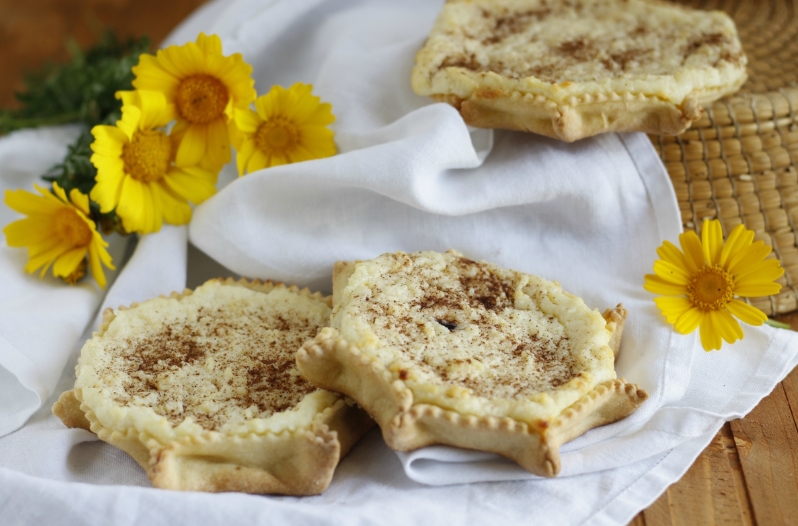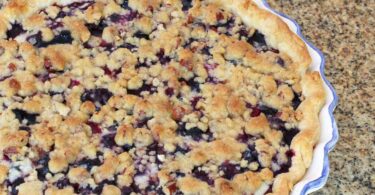Cassatelle are typical Sicilian pastries filled with lemon scented ricotta, and also known as cassateddi in Sicilian dialect. The name derives from the word cassata, and by adding the diminutive suffix ‘ella’ you get the word cassatella, a smaller individual serving. An assortment of these pastries can be found in different regions of Sicily and are considered traditional deserts for the Carnevale and Easter period. In researching this topic, I become enthralled by the history behind the most complex of cassate from Palermo through to these more simple-to-make pastries from Siracusa, and therefore could not help but share some of its history with you.
Sicily is known as the sweets centre of Italy, and it appears that the most colourful and famous cassata siciliana in all its glory, is one of the reasons. It is believed to have originated in Palermo, made with sheep’s milk ricotta – at its richest and herbaceous during Spring; and containing other ingredients prevalent to the area such as pistachios and citrus. The torte originally made in pre-Roman times was connected to the Spring Equinox, however, less opulent in appearance and ingredients. It was made only with ricotta covered in honey and fruits and offered to the earth goddess to secure fertility and the blessing to the Spring sowing.
How to Store Cassatelle Ragusane
Refrigeration: Cassatelle Ragusane can be stored in the refrigerator in an airtight container for about 2-3 days. Keep in mind that over time, the texture of the pastry may become less crispy, but the flavor will remain intact.
Freezing: If you want to store cassatelle for a longer period, you can freeze them. Wrap them individually in plastic wrap or aluminum foil, and then place them in a freezer bag. They can be stored in the freezer for up to 2-3 months. To consume them, thaw them slowly in the refrigerator before reheating them in the oven at 150°C for a few minutes to restore their crispiness.
Beware of Moisture: Since cassatelle pastry is crispy, avoid storing them in humid places or near sources of moisture, as this can make them less crispy. Keep them in a cool, dry environment to preserve their quality.
INGREDIENTS
For the dough:
- 400 g (2 and 2/5 cup) Semolina– Semola di grano duro rimacinata
- 2 eggs
- 80 g (1/3 cup) sugar
- 100 g ( 1/2 cup) lard, room temperature, cut in small pieces
- ~ 50 ml (~3 tbsp) water
For the filling:
- 600 g (2 and 2/5 cup) Ricotta Cheese, drained
- 100 g (2/5 cup) sugar
- 1 lemon zest
- cinnamon powder, to taste
- chocolate chips, to taste
INSTRUCTIONS
- Pour semolina in a bowl along with sugar, eggs and lard and start mixing. Add a bit of water, just enough to make the dough workable, but compact. Knead the dough until forming a ball. Then cover with a film and let it rest in the refrigerator for 10 minutes.
- In the meantime prepare the filling. In a bowl place the ricotta along with the sugar, a pinch of cinnamon and the grated lemon zest. Mix well all of the ingredients. With an immersion blender (or passing through a vegetable mill) blend it.
- Remove the dough from the refrigerator and roll it out finely (~ 3-5 mm) on a floured surface. Then with a pastry ring (~ 9 cm diameter) or with a tea-plate (for bigger cassatelle) placed on the dough cut circles
- Rise about 1 cm of the dough and pinch with 2 fingers to make an edge. Continue, at a regular distance, to pinch along the entire perimeter of the circle. Try to make as many edges as you can.
- With your fingers pinch well each edge until the base and lightly press the dough between two edges to avoid the cassatelle to open while cooking. Knead left-over dough to make more cassatelle.
- With a sac-à-poche or with a tsp fill the cassatelle with the ricotta mixture. Add some chocolate chips, to taste.
- Bake ricotta cassatelle in a static oven pre-heated at 200 ° C for 15-20 minutes (depending on the size of the cassatelle), or until the base is golden brown.
- Remove from the oven.
- Complete them sprinkling with cinnamon powder!








Leave a Comment